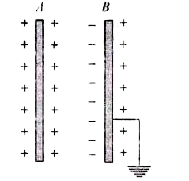Define capacitor and Explain its types and principle.
Capacitor and its principle
Capacitor : It is an arrangement used for storing large amount of electric charge and hence electric energy.
Or
An arrangement of two conditions separated by a dielectric medium is said to form capacitor or condenser. It is of three types :
(i) If the conductors are plane the capacitor is called parallel plate capacitor.

(ii) If the conductors are spherical, the capacitor is called spherical capacitor (iii) If the conductors are cylindrical, the capacitor is called cylindrical capacitor.
Principle : Let us take a plate A . Give some charge to plate A, till its potential becomes maximum. Now consider another plate B, held near plate A. Due to phenomenon of induction, a negative charge is induced on the inner side of plate B and an equal positive charge is induced on outer side of plate B. As the negative charge on plate B is nearer to plate A, hence it is more effective. The negative charge on plate B will reduce the +ve charge on plate a. Hence potential of plate A decreases. In other words, capacity of plate a increases. Now connect plate B to earth. All the positive charge on plate B will go to earth. Now the negative charge on plate B will further reduce the +ve charge on plate a. Hence, potential of plate a further decreases. In other words, capacity of plate A increases. So, when we bring uncharged earth-connected rod near a charge rod, the capacity of charged rod increases.
Uses : Capcitors are used in oscillator circuits, in radio tuning, in filter circuits , in electric fan, in electric motor etc.
Similar Questions
Define buffer solution. Explain its types.
View SolutionDefine mutualism. Explain its one type.
View SolutionDefine capacitor reactance. Write its SI units.
View SolutionDefine capacitance of a capacitor and its SI unit.
View SolutionDefine capacitor reactance. Write its SI units.
View SolutionExplain the working principle of a parallel plate capacitor.
View SolutionWhat is a lever ? State its principle.
View SolutionDerive an expression for the capacitance of a parallel plate capacitor. Explain the effect of dielectrics on capacitance of this capacitor.
Or.
Derive expression for capacitance of a parallel plate capacitor. Explain the effect of dielectrics on its capacitance.
View SolutionBriefly explain the principle of a capacitor. Derive an expression for the capacitance of a parallel plate capacitor, whose plates are separated by a dielectric medium.
View SolutionBriefly explain the principle of a capacitor. Derive an expression for the capacitance of a parallel plate capacitor, whose plates are separated by a dielectric medium.
View Solution
